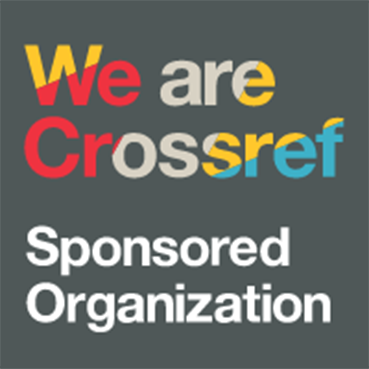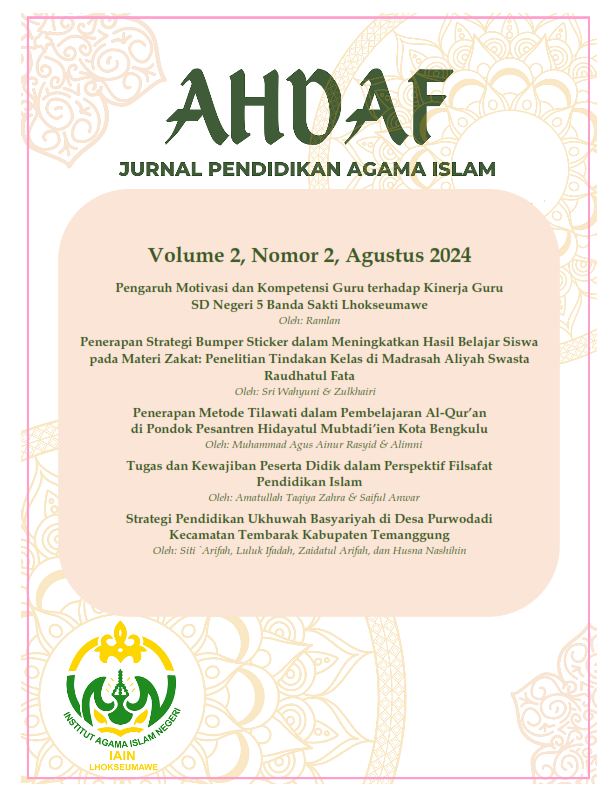Penerapan Metode Tilawati Dalam Pembelajaran Al-Qur’an Di Pondok Pesantren Hidayatul Mubtadi’ien Kota Bengkulu
Main Article Content
Muhammad Agus Ainur Rosyid
Alimni Alimni
This study aims to analyse the planning, implementation, and evaluation of the application of the Tilawati method at Hidayatul Mubtadi'ien Islamic Boarding School, as well as identify the supporting and inhibiting factors. The research method employed is a descriptive qualitative approach, utilizing data collection techniques that include in-depth interviews, observation, and documentation studies. The results showed that the planning of the application of the Tilawati method involved selecting teaching staff with syahādah, preparing learning objectives based on the stages of the students' abilities, and providing media and teaching materials, such as the Kitab Tilawati Volumes 1-6. The implementation of this method combines classical and individual approaches, which have proven effective in improving the ability to read the Qur'an. The main obstacles identified include santri discipline and difficulty in reciting Rost, while supporting factors include the quality of teaching staff, infrastructure, and institutional support. Strategic solutions, such as intensive training, rescheduling sleeping habits, and utilizing the Tilawati Mobile application, successfully overcame the obstacles. This study has implications for the development of technology-based Qur'an learning methods and holistic approaches to improve the quality of education in pesantren.
Chusniyah, A., & Makruf, I. (2024). Manajemen Kurikulum Tahfidz Al-Qur’an di Kuttab Al Faruq Sukoharjo. ISLAMIKA, 6(1), 381-396. https://doi.org/10.36088/islamika.v6i1.4387.
Creswell, J. W. (2014). Research Design: Qualitative, Quantitative, and Mixed Methods Approaches (4th ed.). SAGE Publications.
Denzin, N. K., & Lincoln, Y. S. (2000). Handbook of Qualitative Research. SAGE Publications.
Faizin, M. F. (2020). Efektivitas Pembelajaran Tahfidz Al-Qur’an melalui Habituasi di Pondok Pesantren Hamalatul Qur’an Jogoroto Jombang. Hamalatul Qur’an: Jurnal Ilmu Ilmu Alqur’an, 1(2), 63-78. https://doi.org/10.37985/hq.v1i2.12.
Fitria, Y., & Fitriani, W. (2023). Analisis dan Solusi Kesulitan Belajar dalam Pendidikan Islam: Perspektif Al-Qur’an. ITQAN: Jurnal Ilmu-Ilmu Kependidikan, 14(1), 83–96. https://doi.org/10.47766/itqan.v14i1.1379.
Hersey, P., & Blanchard, K. (1997). Management of Organizational Behavior: Utilizing Human Resources. New Jersey: Prentice Hall.
Istiana, A. (2024). Integrasi Teknologi dalam Pembelajaran Pendidikan Islam. Indonesian Research Journal on Education, 4(1), 302–310. https://doi.org/10.31004/irje.v4i1.493.
Kementerian Agama RI. (2021). Laporan Tahunan Kinerja Pendidikan Islam 2021. Jakarta: Kemenag RI.
Kvale, S., & Brinkmann, S. (2009). InterViews: Learning the Craft of Qualitative Research Interviewing (2nd ed.). SAGE Publications.
Lincoln, Y. S., & Guba, E. G. (1985). Naturalistic Inquiry. SAGE Publications.
Marzano, R. J. (1998). A Theory-Based Meta-Analysis of Research on Instruction. Aurora, CO: Mid-Continent Regional Educational Laboratory.
Miles, M. B., & Huberman, A. M. (2014). Qualitative Data Analysis: An Expanded Sourcebook (2nd ed.). SAGE Publications.
Murtaqiatusholihat, M., Ali, M., & Hernawan, A. H. (2023) Pelatihan Metode Tilawah Evaluasi Simpel (TES) Untuk Meningkatkan Kompetensi Guru Tahfidz Alquran. DWIJA CENDEKIA: Jurnal Riset Pedagogik, 7(1), 474-484. https://doi.org/10.20961/jdc.v7i1.73597.
Nasirudin, M., Faizah, M., Ashar, S., & Dewi, M. K. (2021). Penerapan Metode Tilawati dalam Pembelajaran Membaca Al-Quran di Pondok Sabilul Huda. Jumat Ekonomi: Jurnal Pengabdian Masyarakat, 2(2), 127–131. https://ejournal.unwaha.ac.id/index.php/abdimas_ekon/article/view/2018
Nurhasanah, N., Fatimah, N. (2023). Penerapan Metode Pembelajaran Tilawati Terhadap Membaca Al-Qur’an Santri Rumah Belajar Bola Masagena Dusun Tanreassona Kabupaten Pinrang. Lasinrang (Literasi Pendidikan Islam dan Ruang Analisis Guru), 2(02). https://jurnallasinrang.org/index.php/ls/article/view/23.
Piaget, J. (1952). The Origins of Intelligence in Children. New York: International Universities Press.
Rogers, C. R. (1983). Freedom to Learn for the 80s. Columbus, OH: Charles E. Merrill Publishing.
Sandy, S., & Irham, I. (2021) Penerapan Metode Tilawati dalam Pembelajaran Membaca Al-qur'an Siswa di SMP Al Muslim Bekasi. Turats Jurnal Pendidikan Islam, 14(1), 45-65.
Santoso, S. A. (2018). Implementasi Metode Iqra’dan Metode Tilawati dalam Pembelajaran Al-Qur’an di Madrasah Diniyah Al-falah Modung Bangkalan. Jurnal Pendidikan Islam, 4(1), 2-18. https://doi.org/10.37286/ojs.v4i1.32.
Tilaar, H. A. R. (2015). Manajemen Pendidikan Nasional. Jakarta: PT Rineka Cipta.
Vygotsky, L. S. (1978). Mind in Society: The Development of Higher Psychological Processes. Cambridge, MA: Harvard University Press.
Walidin, Saifullah, & Tabrani. (2015). Metodologi Penelitian Kualitatif. Deepublish.
Widhawati, R., Maryadi, S. A., & Yulistani, A. (2020). Hubungan Kuantitas Tidur dengan Konsentrasi Belajar Remaja di Pondok Pesantren Madinatunnajah Tangerang Selatan. Jurnal Kesehatan STIKes IMC Bintaro, 3(2), 105–110. http://jurnal.stikesimcbintaro.ac.id/index.php/djs/article/view/94.
Yin, R. K. (2014). Case Study Research: Design and Methods (5th ed.). SAGE Publications.




